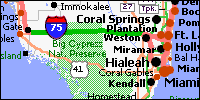Florida State Information Guide
Capital: Tallahassee
March 03, 1845 (27th state)

Called the "Sunshine State," Florida is known for its balmy, sunny weather and beautiful beaches. Ponce de Leon, in search of the elusive fountain of youth, was the first European to explore Florida. St. Augustine, founded by the Spanish in 1565, is the oldest permanent European settlement in the continental United States. Florida became a state on March 3, 1845, a move delayed by the reluctance of Congress to admit another slave state, and it joined the Confederacy on January 10, 1861, re-entering the Union at war's end. Florida's state flower is the orange blossom, which is particularly fitting because oranges are a main export of the state. Because of its shape and location, a long peninsula between the Atlantic Ocean and the Gulf of Mexico, Florida attracts millions of visitors each year to its many seaside resort areas. Its capital is Tallahassee.
Florida State State Resources and State Information
Florida Almanac: Facts and Figures, Economy, and Geography
Florida College, Universities, and Schools
- Florida Colleges and Universities
- Florida Public Colleges
- Florida Community Colleges
- Florida Private Colleges & Independent Schools
Florida Cities Colleges:
- - Altamonte Springs
- - Auburndale
- - Boca Raton
- - Bonita Springs
- - Boynton Beach
- - Bradenton
- - Brandon
- - Casselberry
- - Clearwater
- - Coral Springs
- - Dania
- - Daytona Beach
- - Deland
- - Delray Beach
- - Fort Lauderdale
- - Fort Myers
- - Gainesville
- - Greenacres
- - Hialeah
- - Holiday
- - Hollywood
- - Jacksonville
- - Kissimmee
- - Lake Mary
- - Lake Worth
- - Lakeland
- - Largo
- - Lauderdale Lakes
- - Lutz
- - Maitland
- - Melbourne
- - Miami
- - Miramar
- - Mount Dora
- - Mulberry
- - Nashville
- - New Port Richey
- - Ocala
- - Orange Park
- - Orlando
- - Ormond Beach
- - Palm Beach Gardens
- - Palm Harbor
- - Pembroke Pines
- - Pensacola
- - Pinellas Park
- - Plantation
- - Pompano Beach
- - Port Charlotte
- - Port Saint Lucie
- - Riverview
- - Saint Petersburg
- - Sanford
- - Sarasota
- - Seminole
- - Spring Hill
- - Stuart
- - Tallahassee
- - Tampa
- - Temple Terrace
- - West Palm Beach
- - Winter Haven
- - Winter Park
Florida Medias
Florida History, Timelines, and Famous People
- Florida First Inhabitants
- Florida History
- Florida Timeline
- Florida Famous People
- Florida State Facts
Florida Counties
Florida Symbols
Other Florida Resources
- Missing Children
- CapitolImpact.com - Government Gateway
- Kaiser StateHealthFacts.org - Health Facts
- National Center for Missing & Exploited Children
- Encyclopedia Britannic
- CareerBuilders - Jobs
- National Park Guide
- State Home Page
- State Transportation Department

The 50 US States





